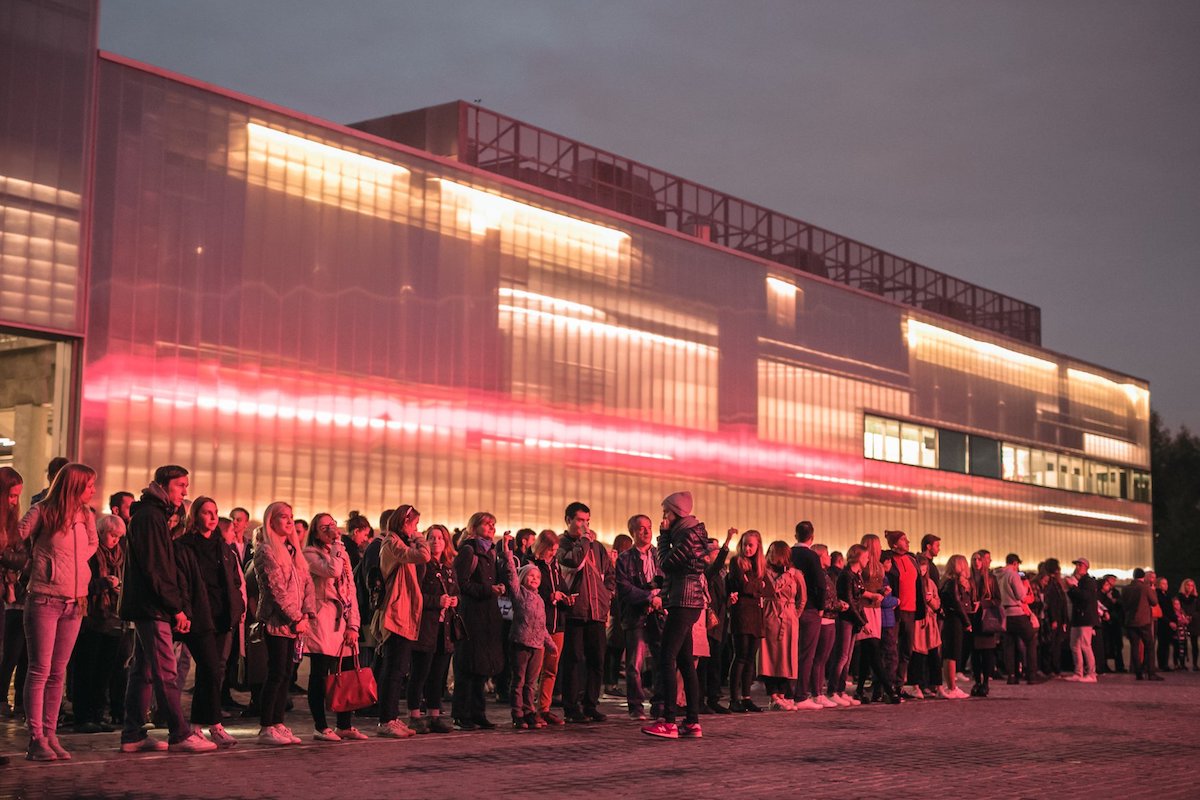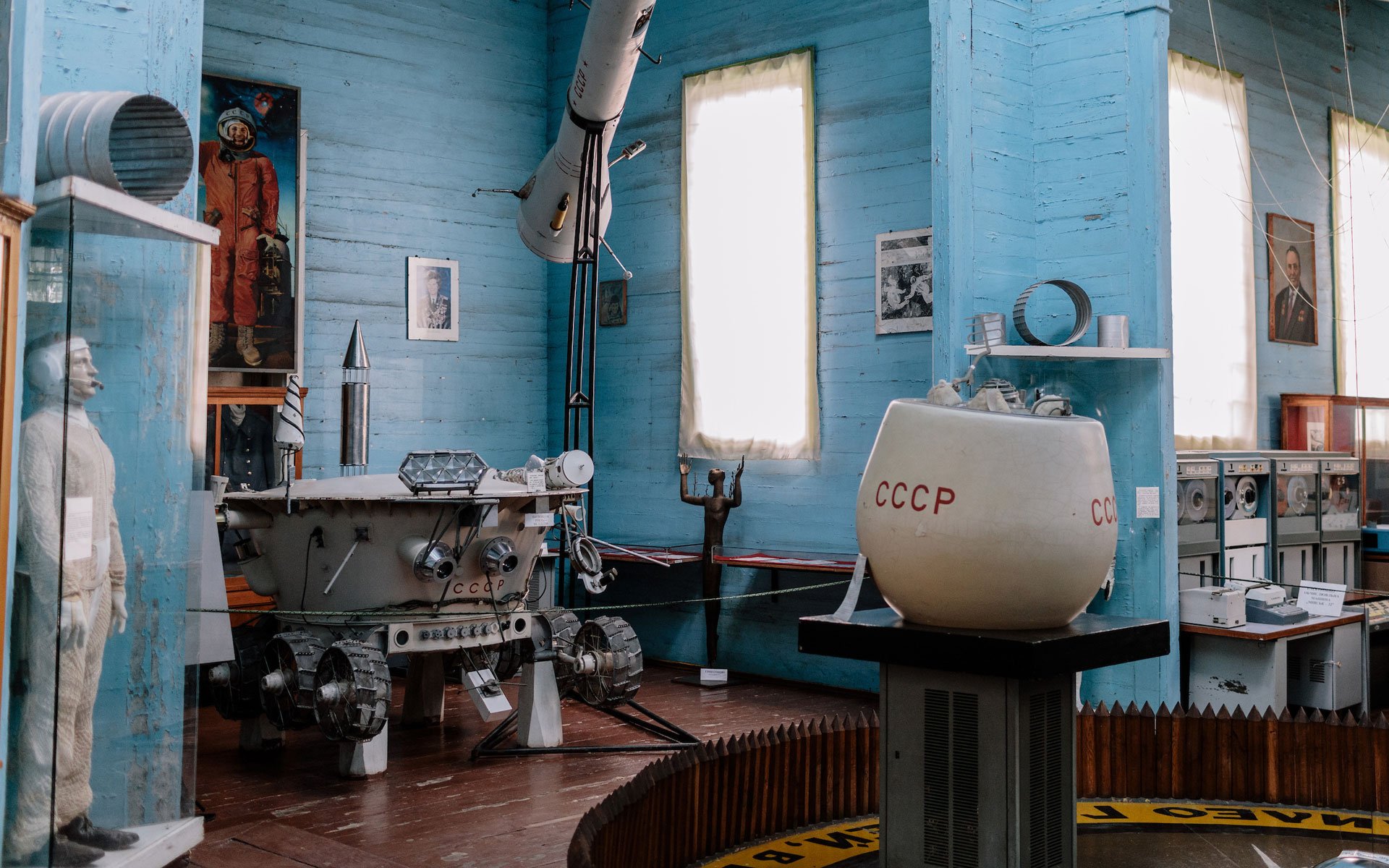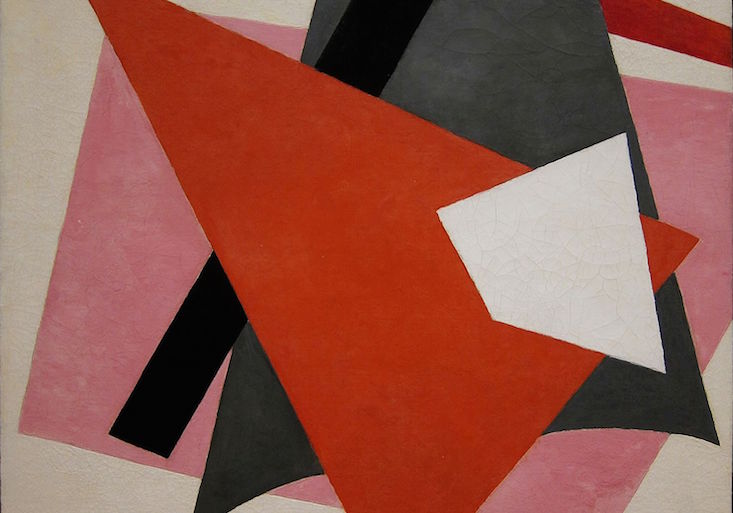The improbable story of how a Ukrainian village museum claimed to hold some of art history’s greatest masterpieces
Secluded deep in the Ukrainian countryside, the Parkhomivka Museum hides a treasure trove of apparently priceless art. But as the story of this rural gallery which exhibited the art world greats quickly becomes legend, questions on the paintings’ authenticity remain a mystery that few seem willing to unravel.
Elena Semenchenko enters the room with a studied hand gesture towards the crown jewels of her countryside museum. The two paintings, one by Kazimir Malevich, the other bearing the signature of Russian avant-garde master Wassily Kandinsky, are masterpieces that cemented this rural outpost’s unlikely reputation as an artistic haven, giving the museum its moniker as “Ukraine’s Hermitage”.
The Malevich has particular significance, the museum’s director explains, because the future founder of the Suprematist movement actually lived here for a few years in the 1890s. It’s one of the few unusual things about Parkhomivka, an isolated village of about 3,000 inhabitants almost 400km east of Kyiv. Another is the museum itself and the incredible artworks exhibited between its walls. Semenchenko also proudly showcases a landscape by the French impressionist Camille Pissarro, two Picasso drawings, and a portrait by Rembrandt student Ferdinand Bol.
But when the obvious question comes — how did such masterpieces land there? — Semenchenko turns away, and briefly hesitates. The Malevich and Kandinsky paintings were both gifted to Afanasiy Lunev, a local history teacher who founded the museum in the early 50s and died in 2004. She does not know who the generous donor was, nor when Lunev came into possession of those invaluable treasures (the last Malevich work to be publicly auctioned sold for $85m).
Is she not curious? “In his entire life, he never said,” Semenchenko answers. “I don’t know. Maybe it’s his secret.”
The museum’s legend is built in many ways on its location: a cultural institution located in a small, isolated, hard-to-reach village
Lunev’s secret is part of a story that made Parkhomivka, an otherwise unassuming village deep in the Kharkiv region, a self-proclaimed hidden gem of the Ukrainian art world, with a treasure trove of more than 6,000 exhibits (only a small part of which are exhibited) only accessible to those ready to drive the 100km of pothole-ridden roads from Kharkiv, the regional capital.
It’s a story of abnegation and passion, of a beloved history teacher who, thanks to his stubbornness and charisma, managed to attract the attention of some of the Soviet Union’s most famous artists, and create a one-of-a-kind village museum. It’s a story that Ukrainians have long enjoyed reading and re-telling, with hundreds of articles and blog posts written about it since the late 90s. Some of them mention other incredible artworks reportedly stored in the museum — a Gauguin, a Renoir, a painting by Rembrandt himself, Manet, Cezanne, Matisse. “[There’s] no need to go abroad to see Rembrandt, Malevich, and Picasso with your own eyes!” Ukrainian TV channel 24 wrote on its website in May 2018. In 2019, then-Foreign Minister Pavlo Klimkin praised the museum on his Facebook page, encouraging Ukrainians to “come to the museum and bring their foreign friends [...] to see this impressive collection.”
But it’s also a story that hardly seems to hold water when probed just a little bit closer. It’s not only the Kandinsky and Malevich which have never had a written statement of authenticity from an expert. “Spring,” a painting the museum says was gifted by the St Petersburg Hermitage museum “cannot be attributed to Camille Pissarro” despite the museum’s claim, according to Christophe Duvivier, the director of the Camille-Pissarro museum in Pontoise, France.
The Picasso drawings aren’t fake, according to a representative of Picasso Administration, the company in charge of protecting the painter’s inheritance, but neither are they genuine: rather, they are most likely to be authorised reproductions made for one of the Picasso exhibitions held in the Soviet Union. A ceramic attributed to Picasso and also exhibited in Parkhomivka could, however, be authentic, the company said.
The museum has quietly dropped some of the claims made over the years. The names Rembrandt, Cézanne, Manet or Renoir have disappeared, replaced in many cases by attributions to an “unknown artist”.
But doubts about the authenticity of some of the museum’s most prestigious exhibits never seem to have really hurt its status among the Ukrainian media – or the 15,000 people visiting it every year. The story of the masterpieces hidden in the Parkhomivka Museum might not be true, but it’s more than simple “fake news.” Carefully grown over 60 years, they have become part of a national myth.
The museum’s legend is built in many ways on its location: a cultural institution located in a small, isolated, hard-to-reach village, a place that no one in their right mind would see fit to host any kind of museum, let alone one with masterpieces of global art.
Interior of the Parkhomivka Museum. Image: Fabrice Deprez
Parkhomivka sits between two long hills, stretching over eight kilometres and seemingly cut lengthwise by a road running along the valley. A sugar factory first built at the end of the 19th century stands in the middle, a couple dozen metres from the village’s main intersection where the shops, post office, and a Second World War memorial are located. In the summer, trucks passing through the main road kick clouds of dust on the nearby houses, giving the place the appearance of a frontier town.
The museum, housed in the rosy palace of a former local noble, is hidden up the hill at the end of a meandering road that goes past the factory, past the house where a young Malevich lived, and past an Orthodox church built in the early 20th century. But there’s another edifice on the slope of the other hill that is key to understanding the museum’s rise: a two-storied building of bricks and white paint where the museum’s founder, Anafasy Lunev, started teaching history in the late 40s. It’s still the village’s school, though not for long: just a few metres away, workers are putting the finishing touches on a freshly renovated building, part of a state-wide program giving additional resources to 200 schools across Ukraine.
Valentina Karabut has started her history lesson and, while the schoolchildren silently read their manuals, tells me another story. The tale of the Parkhomivka Museum is one the 58-year-old history teacher knows well, partly because she lived it as one of the schoolchildren who helped run the project, and partly because she’s been telling it to journalists for the better part of two decades. It is, in her words, first and foremost the story of a great man, Afanasiy Lunev.
The names Rembrandt, Cézanne, Manet, and Renoir have disappeared, replaced in many cases by attributions to an “unknown artist”
In the wake of the Second World War, 26-year-old Afanasiy Lunev was assigned as a history teacher to the village of Parkhomivka and quickly encouraged his students to roam around the region in search of historical artifacts: icons, watches, antique coins, old bibles.
Lunev formalised his students’ escapades with the creation of the “young historians” club, and gathered the children’s findings in a small classroom, the first iteration of the Parkhomivka Museum.
The project took off when the teacher and his students wrote dozens of letters to artists and museums across the Soviet Union, asking them to send their own artworks to Parkhomivka. Many responded positively, including the Hermitage Museum in St Petersburg and the Pushkin Museum and Tretyakov Gallery in Moscow. Media coverage gave the project wide recognition: in April 1963, a report on the Soviet Union’s second congress of painters published by the Pravda newspaper. The report, which sat side-by-side with a story on a NATO meeting in Paris titled “the aggressors meet on the banks of the Seine river”, lauded the “wonderful institution” which “has become a centre of aesthetic education for the village’s inhabitants”.
Through it all, the driving force was Lunev, a charismatic, self-taught art lover, says Karabut. Semenchenko similarly characterises him as someone who “taught more than history: he taught life”.
Afanasiy Lunev surrounded by well-wishers. Image courtesy of VN Karazin Kharkiv National University.
But the story has a more political side, one that Karabut, Semenchenko, and most other people close to the museum did not experience first hand and omit in their stories.
Valentina Myzgina, the director of Kharkiv’s art museum, remembers it better than most.
I meet her some 100km east, in a large office tucked at the end of a cramped corridor at the museum where she has worked since 1970. Her eyebrows raise slightly when I tell her I was in Parkhomivka the day before. “So, you’ve seen the roads?”, she asks. I have; they’re not the best, I concede. Myzgina leans back in her chair. If it’s bad now, she says, imagine how it was in the 50s, when Afanasiy Lunev first set up the museum. “For that,” she says, “I have huge respect for him.”
Parkhomivka Museum is now a branch of the Kharkiv art museum, but back in Lunev’s heyday, Myzgina was able to watch him work from a more objective distance. “Lunev was a very active, very communicative person,” she remembers. “But he was also at the right place at the right time.”
Lunev worked on his project throughout the 1960s, when artists and some Soviet officials looked to take advantage of Khrushchev’s thaw to change the way art was being taught in schools. Lunev’s teaching style, which encouraged his students to go out and see “with their hearts rather than their eyes”, in the words of Semenchenko, is what they were looking for.
In the 50s, Lunev started a correspondence with Boris Nemensky, a Russian painter and high-ranking member of the Artists’ Union who immediately embraced the project, sending several of his artworks to Parkhomivka.
Lunev had found an enthusiastic and influential political patron who encouraged the history teacher to “propagandise your ideas (our ideas!) among the youth” and promised in another letter to “energetically” press the Komsomol Central Committee to financially support the museum. The painter also became the head of the Artists’ Union’s commission on artistic and aesthetic education in the 1970s, making his friendship with Lunev all the more valuable for the museum.
The political intricacies of the museum’s rise do not matter a lot to Karabut. She prefers to talk about the excursions to Moscow, Leningrad, and other Soviet cities that the project’s success allowed the village’s schoolchildren to go on, and when she does, her eyes light up, her hands raise to her chest. “Imagine us, children from Parkhomivka, going to a concert at the [Moscow] Palace of Congresses with a thousand other people!” In the Russian capital, they also met with Soviet artists who would show their workshops and hand the schoolchildren some of their works to be taken back to Parkhomivka. They’d spend a week there, sleeping in a university dormitory, “three meals a day, all for free”.
The Hermitage Museum in St Petersburg confirmed in an email having donated 345 exhibits to the Parkhomivka Museum between 1964 and 1988: religious icons, porcelain, ceramics, ancient Egyptian art
The pictures of chaotic joy evoked by stories of Parkhomivka children coming back to the village on open-air trucks filled with artworks also give Semenchenko an explanation for the cloud of uncertainty surrounding many of the museum’s exhibits. “We often don’t know because the children didn’t always make receipts… so today we try to reconstruct where exactly they came from.” The implication is that, in most cases, Lunev himself decided on the name that would appear under the painting.
One notable exception are the Picasso artworks, in front of which Semenchenko can stop to give details. One of the many contacts that Lunev made in his letter-sending campaign was Ilya Ehrenburg, a Soviet writer and journalist who befriended Picasso during his exile in Paris between 1908 and the start of the First World War. Ehrenburg later became instrumental in organising the first ever Picasso exhibit in the Soviet Union in 1956, as well as the second, 10 years later, and was able to set aside the (most likely) reproductions, as well as a vase for the Parkhomivka Museum. Both Lunev’s correspondence with Ehrenburg as well as Ehrenburg’s friendship with Picasso are well-established.
The provenance of other works ranges from clearly set – French-Belarusian artist, Nadia Léger, donated two large mosaic portraits to the museum — to confused, such as with artworks like Camille Pissarro’s “Spring” painting that was reportedly given by Russian museums.
The Hermitage Museum in St Petersburg confirmed in an email having donated 345 exhibits to the Parkhomivka Museum between 1964 and 1988: religious icons, porcelain, ceramics, ancient Egyptian art, as well as 90 other drawings and paintings. But, crucially, it denies ever gifting the Pissarro painting.
Exterior of the Parkhomivka Museum. Image: Fabrice Deprez
And then there are the Kandinsky and Malevich paintings. While other world famous exhibits could be real but misattributed works of arts, these two painters’ distinctive style means the paintings exhibited in the Parkhomivka Museum can only be either genuine or forgeries. Konstantin Akinsha, an art historian and former curator at the Kyiv Museum of Western and Oriental Art, said in an email that he had seen the Malevich painting during an exhibition in the United States. Its authenticity is “highly questionable, to put it mildly,” he wrote.
The USSR was instrumental in Lunev’s success, and its collapse brought difficult times for both the village and the museum. The emergence of an independent Ukraine at first meant economic crisis for Parhomivka, as funds from Moscow dried up and the sugar factory became entangled in a complicated privatisation process. More importantly for Lunev, by then in his 70s, the Parkhomivka Museum became a branch of the Kharkiv art museum. Lunev effectively kept control of the institution until his death, but the transition left him bitter.
The myth of the Parkhomivka Museum was born in the USSR. By the time it collapsed, it had become strong enough to survive it
He nevertheless fought back in a war of attrition with “the people from Kharkiv”; Valentina Myzgina and her colleagues. In the early 90s, a team from the Kharkiv museum offered to come to Parkhomivka in order to document the exhibits and make new tags for them. “We called Lunev and he told us sure, come!”, recalls Myzgina. “So we came. Except we could not get into the museum, because he had painted the floors, and it took three days to dry the paint. So we stayed overnight, went back to Kharkiv the next day, and did not change the tags.”
These were the first cracks in the museum’s legend. An article about the museum written in 1998 by a journalist from the Russian newspaper Moskovskiye Novosti continued to widen them. In contrast to the cheering reports published in the tightly-controlled Soviet media, his story was deeply mocking and sarcastic, mentioning the “Pissarro, Gauguin, and Manet that [Lunev] stubbornly calls original.” It also quotes the museum’s founder explaining that he got the Pissarro painting by exchanging it for a bunch of newspaper “in the first years of Soviet power,” despite the museum’s current claim that is was a donation from the Hermitage Museum.
By then, however, Lunev and his (now adult) former schoolchildren were too committed to become dislodged. The myth of the Parkhomivka Museum was born in the USSR and grew over 30 years in the controlled environment of the Soviet system. By the time it collapsed, it had become strong enough to survive it, with people who had invested nearly their whole life in the project ready to defend it and, after Lunev’s death in 2004, to staunchly safeguard their teacher’s legacy. Lauding media stories about the museum kept coming in, with Malevich and Picasso as the lede, Lunov’s brilliance as the flesh.
Many now take the view of Volodymyr Danylenko, who grew up in Parkhomivka as one of Lunev’s pupils, and later was elected deputy in the first parliament of the newly independent Ukraine. Like others, Danylenko is reluctant to discuss the authenticity issue, but the same gratitude colours his voice when he remembers his role in the museum. For the people of Parkhomivka, the importance of the collection lies in the opportunities it has given them, rather than whether the artworks are the genuine treasures they claim to be. “We countryside kids didn’t have the opportunities of city people to go to the theatre, meet with artists, with painters,” Danylenko says. “God gave us that opportunity.”


